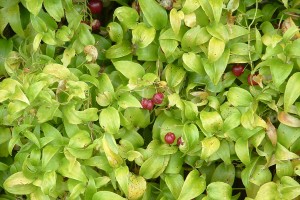Bridal creeper rust
History in New Zealand
The bridal creeper rust is native to South Africa. It was first released in Australia in 2000 and spread to over 1500 sites by the end of 2003. In November 2005, the rust was found in Auckland and subsequent field surveys showed that it was also present in Northland, Bay of Plenty and Wairarapa. The rust is widespread in the North Island and is causing heavy defoliation and dieback of bridal creeper plants (Asparagus asparagoides). It is believed to have arrived naturally to New Zealand from Australia by wind.
How would I find/recognise it and what is its lifecycle?
Bright yellow spots are visible on the upper side of the leaf and bright yellow-orange pustules form on the underside of leaves and on stems. These pustules release yellow spores (urediniospores) which are present throughout the active growing seasons (winter-spring and autumn). A few small spots will be visible on bridal creeper at first before increasing in number.
Image: yellow spots caused by bridal creeper rust.
Black pustules can also be visible. These contain teliospores which are “resting spores” and help the rust survive in unfavourable conditions.
Image: yellow and black bridal creeper rust pustules.
Teliospores germinate to produce basidiospores which are dispersed by wind. When basidiospores land on bridal creeper leaves under humid conditions, they germinate and grow into leaves, producing pustules. These form aeciospores which in turn germinate and produce urediniospores.
When urediniospores land on bridal creeper leaves or stems, they germinate and infect the plant. Infected areas turn yellow and form pustules. These pustules erupt and release new urediniospores. The wind disperses these spores, spreading the disease around. When conditions are unfavourable, teliospores will be produced. Severely infected stems turn brown, and plants become completely defoliated and die.
You might confuse the bridal creeper rust with another fungus from the genus Colletotrichum that forms brown circular leaf spots and occasionally leaf yellowing. However, the characteristic yellow pustules on the lower leaf surface caused by the bridal creeper rust should prevent any confusion with this fungus.
How does it damage bridal creeper?
The infection process damages the epidermis of leaves and stems causing them to die prematurely.

Image: leaf dieback from bridal creeper rust.
Image: leaf dieback from bridal creeper rust.
Will it attack other plants?
The rust is specific to bridal creeper. It is unlikely to damage the closely related weed climbing asparagus (Asparagus scandens), the cultivated asparagus (Asparagus officinalis) or any other plants.
How effective is it?
Damage caused by the bridal creeper rust is often severe, with premature defoliation and dieback.
Image: bridal creeper rust damage.
Image: bridal creeper rust damage.
Image: bridal creeper rust damage.
A glasshouse experiment in Australia showed that the rust was capable of reducing the tuber number, rhizome length and shoot biomass by approximately 60% within 20 weeks. Long-term field monitoring in Australia also found that bridal creeper populations were considerably reduced with consecutive seasonal epidemics of the bridal creeper rust, enabling native plants to regenerate.
How can I get the most out of it?
The bridal rust disperses naturally via spores on air currents. It is already widely established so there is little to gain by spreading it around further.



